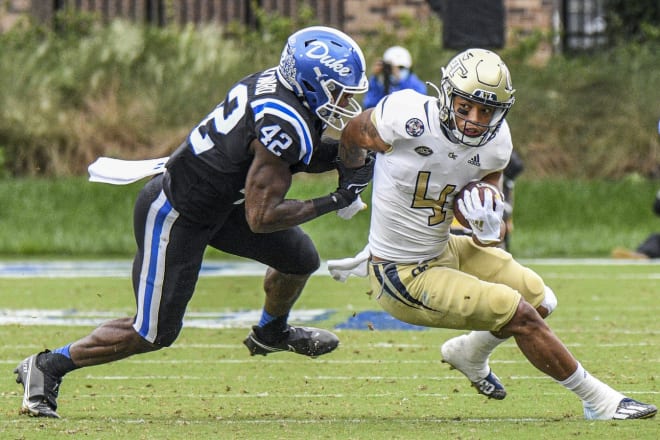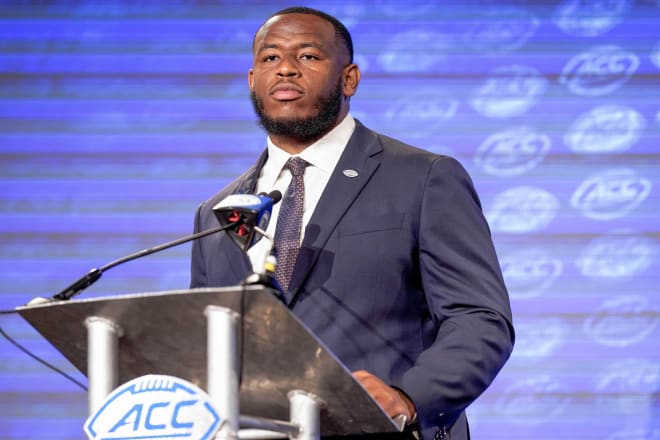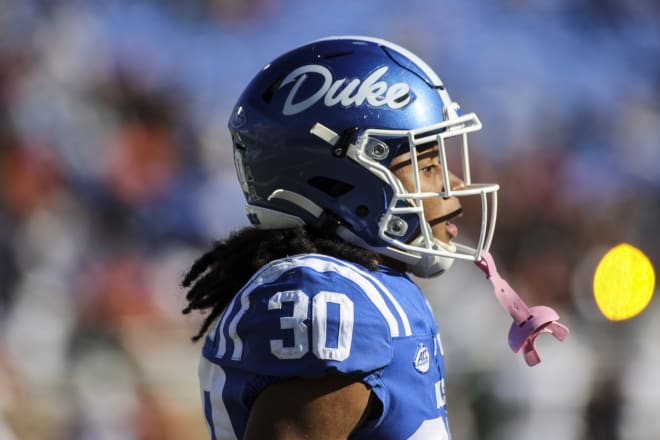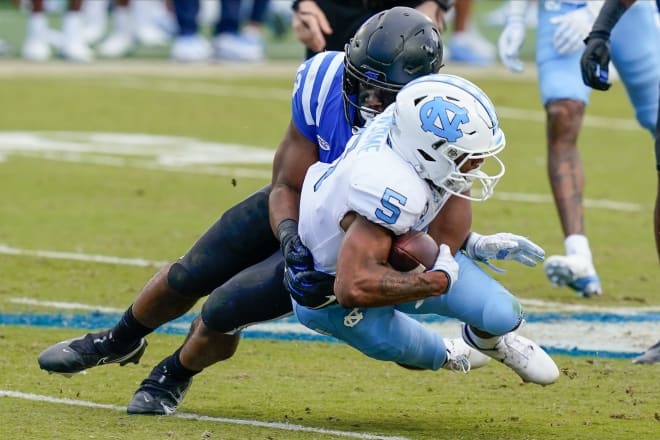Kind of projecting Duke’s defensive and special teams depth chart
Who might line up in key spots defensively and on special teams for Duke in the season-opening game against Temple? Let’s take a stab at it

This won’t be a lifting of the veil as much as it’s just a partial peak behind the curtain.
Similar to the story posted a couple of days ago forecasting Duke’s offense, this is a look at who is “above the line” for Duke’s defense and special teams.
Every coach at every level thinks of players in a basic sense: Are they playable or unplayable?
The Blue Devils getting playable guys for their defense would be a step in the right direction after recent seasons.
Duke allowed a national-worst 517.9 yards per game last season. The 39.8 points per game allowed was even worse than the 38.1 points per game allowed in 2020. Duke has allowed more than 30 points in 17 of its last 21 games.
Every issue isn’t going to be solved with the arrival of a head coach who spent the last 17 seasons as a defensive coordinator.
What Mike Elko and his defensive staff can do, though, is revamp and modernize Duke’s scheme and put players in position to make plays. The idea is to cover whatever talent gaps might exist with the strength and conditioning work that was put in over the summer, and by being the most physical team in the ACC.
Here is Duke’s defensive and special teams “above the line”:
Defense
Defensive ends
Vincent Anthony Jr. | 6-6, 240
Anthony Nelson | 6-2, 254
R.J. Oben | 6-4, 255
Michael Reese | 6-3, 259
Ends overview: Hopefully you know a decent amount about Anthony already. It was a mistake to include him in the “key developers” story in July, and the “key newcomers” story should have made amends.
The hometown freshman is going to play and has a chance to be special.
Oben led Duke with five sacks last season, second on the team in QB pressures (29, per Pro Football Focus).
Nelson – along with one of the linebackers we’ll get to momentarily – didn’t come in with the most fanfare as a grad transfer from Harvard. In 24 career games for the Crimson, Nelson had 56 tackles, 11 TFLs and eight sacks.
But he just kept working his way into favor with Duke’s staff in fall camp, to the point that he’s seemingly going to be a contributor this season.
This did not feel like that deep of a position for the Blue Devils in fall camp. Maybe that changes and other options emerge during the season – but it feels like the depth of Duke’s defensive line rotation is reliant on the tackles.

Defensive tackles
DeWayne Carter | 6-3, 298
Ja’Mion Franklin | 6-2, 311
Michael Larbie | 6-foot, 273
Aeneas Peebles | 6-1, 288
Tackles overview: Carter led Duke with 37 QB pressures last season, also racking up 4½ sacks and four forced fumbles.
Carter is entering his second season as a captain for the Blue Devils and will be one of the most-important individuals on the team. Turning around Duke’s defensive performance from the last two seasons begins up front, where Carter is a leader and playmaker.
It won’t be all on him, though.
Franklin didn’t have much of an impact last season (12 games, 14 tackles) but he was one of the more consistent defensive players in fall camp. It helps that he’s also the largest defensive lineman on the team. The Notre Dame transfer is one of the many players who benefited from strength and conditioning coach David Feeley’s summer program.
Peebles brings more experience to the interior of the line, having played 302 snaps last season. He seemed to find another gear in his play about halfway through camp.
Larbie is the X-factor here, a little undersized compared to the other three tackles. The fourth-year tackle has played the fewest career snaps of any tackle listed here, but was earning significant snaps by the end of fall camp.

Linebackers
Cam Dillon | 6-2, 229
Tre Freeman | 6-foot, 234
Shaka Heyward | 6-3, 240
Dorian Mausi | 6-2, 225
Linebackers overview: Heyward and Mausi were the starting duo last season, playing the most snaps of anybody on Duke’s defense (Heyward played 834 of Duke’s 904 total snaps; Mausi played 736).
They’re both strong players but Duke needs to find a way to keep them fresher, and that’s where the emergence of Dillon and Freeman becomes important.
Dillon is the other Ivy League transfer who, like Nelson, arrived with little attention but forced his way into a key role as camp got into the second and third weeks. The Columbia graduate rarely seemed out of position – that’s a key trait with a first-year staff that’s doing a lot of hands-on teaching.
Freeman was one of the stars of the spring game but struggled early in camp.
It comes back to Heyward and Mausi, though.
Heyward is not the most vocal of players on Duke’s defense but has worked on being more of a leader. Defensive coordinator Robb Smith, who’s also the linebackers coach, noted Heyward’s quiet leadership style means when he speaks, players listen.
“Shaka by nature is not a loud person, but he’s a really smart football player,” Smith said. “When we’re in the big room together and Shaka says something, people listen to him.”
Mausi, on the other hand, is an avid communicator – so the two middle components of Duke’s defense complement each other well.
“I think those two are really developing a good tandem this training camp, in terms of working together,” Smith said. “A lot of it is you’re fitting off of each other at certain times and you’re anticipating what the other guy is going to do.
“They’ve gotten a lot of cumulative reps together and that’s been positive.”

Nickel
Brandon Johnson | 5-9, 180
Cameron Bergeron | 6-foot, 177
Overview: Truth be told, a couple of the cornerbacks you’ll see in the next position grouping could also appear in this spot.
The nickel position has looked more like a third cornerback in Duke’s new defense, rather than the third safety that it’s been in so many previous seasons. With the majority of ACC offenses running 11 personnel (one running back, one tight end, three receivers) as their base offense, this fifth defensive back almost has to be a cornerback in order to match up.
Johnson has looked like a natural fit at nickel. He only played 90 snaps last season, but 46 of those came in the final two games, including the only start of his career in the finale.
Bergeron bounced around to a couple of spots within the defense before it looked like he settled in at nickel.

Cornerbacks
Tony Davis | 6-2, 195
Joshua Pickett | 6-foot, 186
Chandler Rivers | 5-10, 182
Datrone Young | 5-9, 179
Cornerbacks overview: Young didn’t transfer from Iowa State to spend his sixth season of college football providing depth and, as Elko noted during fall camp, he and safety Darius Joiner were trusted with large roles early.
The size – or lack thereof – shouldn’t be too concerning about Young, who’s fast and physical. The same can be said for Rivers, who’s five years younger but looked ready to play against experienced receivers.
Pickett is part of this second-year class of defensive backs in the secondary who has emerged as a key player after being used sparingly last season.
Depending on what day you came to practice, you either thought Davis was going to play a starring role for this secondary or that he was bound for the scout team.
“Everybody’s journey in camp is a little bit different,” said Smith, who pointed out that the structure of Duke’s fall camp was different than previous seasons. “In anything there’s going to be ups, there’s going to be downs. I think overall Tony and that whole room with (cornerbacks coach Ishmael Aristide) is trending in the right direction.”
Safeties
Isaiah Fisher-Smith | 5-11, 207
Da’Quan Johnson | 6-1, 192
Darius Joiner | 6-2, 200
Jaylen Stinson | 5-8, 173
Safeties overview: Similar to Anthony all the way back up there with the ends, you know that Joiner is a key difference in this defense. He’s a hard-hitting ballhawk who’s likely going to make you wish he had more than one season of eligibility remaining.
Stinson has received acclaim for his kick return skills but that shouldn’t overshadow his work as a safety. He, Fisher-Smith and Johnson are the only three returning players in the secondary who played more than 200 snaps for Duke last season, and Stinson figures to be an integral part of the Blue Devils’ defense this year after being fifth on the team with 43 tackles last season.
Fisher-Smith and Johnson should be key parts of the rotation, too.
It’s worth noting that Elko’s position in college (at Penn) was a safety, and safeties coach Lyle Hemphill is coming off of being Wake Forest’s defensive coordinator. Elko and Hemphill worked together at Hofstra from 2006-08.
Special teams
Kickers
Charlie Ham | 6-2, 212
Todd Pelino | 6-2, 179
Punters
Porter Wilson | 6-5, 233
Jackson Hubbard | 6-3, 181
Kickoffs
Charlie Ham | 6-2, 212
Jackson Hubbard | 6-3, 181
Returners
Long-snapper
Evan Deckers | 6-4, 244
Special teams overview: There should be more returners listed, but I’ve done a poor job of noting which players other than the obvious ones were fielding kickoffs and punts throughout fall camp.
You know Stinson will be the primary kick returner based on last season, and the receivers listed have enough elusiveness and quick-twitch athleticism that they figure to get the first shots at returning punts.
Ham made 14 of 20 field goals last season and had a 40% touchback rate, only putting two kickoffs out of bounds (of 55). Those are solid numbers that should improve with another year in the program.
Wilson had a strong season with 22 of 61 punts downed inside opponents’ 20-yard line, against just three touchbacks.
Elko has preached that Duke has to have an edge in special teams to be competitive, like his predecessor, and Ham and Wilson give the Blue Devils a chance to accomplish that goal.
Among the don’t-scoff category: The addition of Deckers was a big one from the transfer portal.
The UMass transfer has elite times on snaps and assuaged some concern about that position when he arrived in the spring. It’s a position that you’re unlikely to notice unless something goes wrong, and seems unlikely much will go wrong with Deckers handling that duty.
